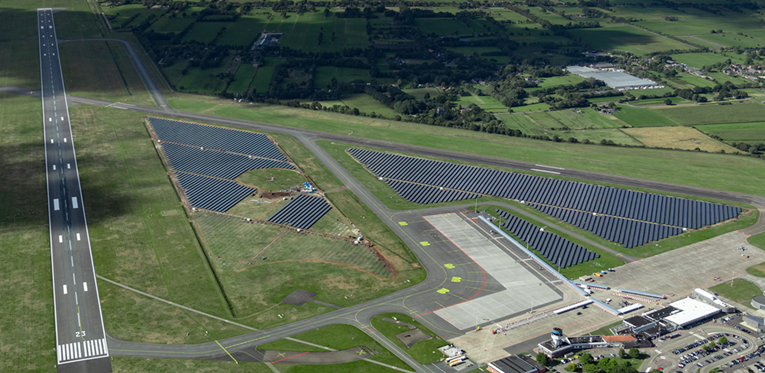Regardless of the impact of the Covid-19 pandemic, the aviation industry is looking to invest significant time, money and resources in renovating and setting high targets to become more sustainable. Why now? The reason is simple: without large investments in greener technologies, the industry will not be able to continue along the same growth trajectory it has always been on.
[blockquote text=”Considering non-CO2 emissions the overall impact of aviation on climate change and the environment could be three times higher.” text_color=”#004361″ show_quote_icon=”yes”]
With half of the world still in lockdown and travel bans in place everywhere, the aviation industry is still in shock and recovery seems a long-distance mirage. In such circumstances, for many players in the aviation industry surviving and keeping the business continuity should be the only thing to focus on. In Europe, however, huge international and national plans have been developed to decarbonise the sector and reach net-zero emission before 2050.
The real aviation impact on the environment
Aviation accounts to 2% of all global human-induced CO2 emission[1] and at the European level this number is estimated to be around 4%. From a recent study[2] published by EASA, it is possible to conclude that, considering non-CO2 emissions, such as NOx, soot particles, oxidised sulphur species, and water vapour, the overall impact of aviation on climate change and the environment could be three times higher. For the record, studies showing similar results have been conducted for other business sectors and, therefore, is difficult to calculate the total real aviation impact on the environment.
The EU and aviation big players strategies
It has been forecasted that, without radical changes, by 2050 the aviation contribution to CO2 will reach 27% of the total CO2 produced by mankind. The European Commission, also to face this potential outcome, has given aviation a central role in programmes such as the Green Deal and Horizon Europe Long-term innovation, research and development plans, such as CleanSky and SESAR have been renewed with new funds. ACI Europe, A4E, ASD, Era and Canso have published their roadmap to reach carbon neutrality by 2050, focusing on new technologies such as SAF, electric and hydrogen aircraft. Grazia Vittadini, Airbus CTO, during the presentation of the Airbus ZEROe concept aircraft, sent a clear message to the aviation industry stating the need to emerge from the pandemic with climate neutrality as a long term competitiveness factor because in today’s world, it would not be possible to do it any other way.
Why should we invest significant funds into the aviation sector to make it greener?
The aviation sector is demanding a huge number of investments to decarbonise and develop new greener technologies. Why should governments and the public support these large scale programmes? There are many reasons we could discuss but a key and most recent one I’d like to highlight is the critical role of aviation during Covid-19 lockdowns and the vaccination campaigns to support fast movement of people and goods and the infinite opportunities of connectivity that aviation allows. These two reasons, of course, come with great responsibility and the aviation industry needs to focus on green technologies, smart developments, and sustainability.
The airport leading role
In the greener and sustainable plans for aviation, airports could become innovation centres where the future of different technologies and mobility will be shaped. Investing now in sustainable strategies and green projects will help airports position themselves as sustainable hubs attracting the emerging and future market segments of new generations. These new generations, understanding not only the importance of aviation but also its impact on the environment, will prefer airlines, airports, and even countries, where environmental sustainability is the core of their business plans.
There are green technologies, such as an extensive use of SAF, that do not require huge investments or new airports’ infrastructures. Lidia Aviles, STX Business Review & Innovation Leader at Skytanking, pointed out that SAF and other ready-to-use tools will help to make this ecological transition starts because “sometimes walking towards the future does not mean a radical change but to adapt” and, as well said by Amélie Lummaux, Environmental Director AdP, by investing now in these technologies, the industry will keep the license to grow and to have the margin required to invest in long term plans, such as hydrogen. For these reasons, airports should begin focusing on developing sustainable roadmaps looking at short medium term plans to keep their business growth and collectively work towards a greener aviation industry.

[1] ATAG
[2] Updated analysis of the non-CO2 climate impacts of aviation and potential policy measures pursuant to EU Emissions Trading System Directive Article 30(4)
About To70. To70 is one of the world’s leading aviation consultancies, founded in the Netherlands with offices in Europe, Australia, Asia, and Latin America. To70 believes that society’s growing demand for transport and mobility can be met in a safe, efficient, environmentally friendly and economically viable manner. To achieve this, policy and business decisions have to be based on objective information. With our diverse team of specialists and generalists to70 provides pragmatic solutions and expert advice, based on high-quality data-driven analyses. For more information, please refer to www.to70.com.

